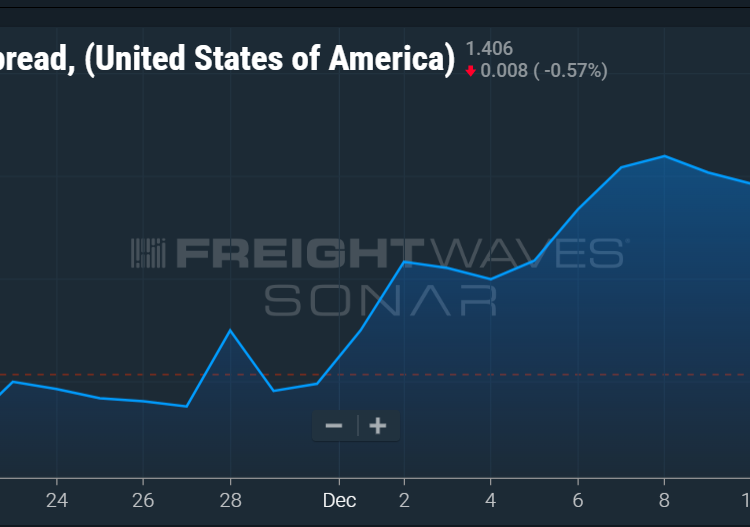While the benchmark diesel price used for most fuel surcharges fell Monday, the eighth consecutive week it has declined, oil futures reacted strongly to the cutbacks in the use of the Suez Canal by shipping companies, including a Monday decision by a major oil company to bypass the Red Sea.
The Department of Energy/Energy Information Administration weekly average retail diesel price fell to $3.894 a gallon Monday. That is down 9.3 cents from the prior week. In the eight-week period of unbroken declines, the price used for most fuel surcharges has fallen 65.1 cents.
But the decline hasn’t been just in that period. The DOE/EIA price has fallen 11 of the past 13 weeks, down 73.9 cents per gallon during that time from the $4.633-per-gallon price on Sept. 18, before that significant series of declines commenced.
However, market conditions in the past several trading days are signaling that retail prices might be challenged to continue dropping.
Oil markets reacted strongly to news that BP was the first major oil company that said it would suspend the movement of its tankers through the Red Sea because of the attacks on shipping launched by the Iran-backed Houthi movement which controls much of western Yemen, including a significant coastline with the Red Sea.
As with other cargo movements, ships avoiding the Red Sea would no longer go through the Suez Canal and instead go around South Africa’s Cape of Good Hope. Flexport last week reported that the added shipping time to go around the Cape instead of through the canal would be seven to 10 days.
Reuters reported data published by the EIA — in turn quoting a company called Vortex — that in the first half of this year, oil transiting the Suez Canal was about 9.2 million barrels a day. With global oil consumption at about 102 million to 103 million barrels/day, that would be about 9% of world oil consumption through the key passage that is now threatened.
The pace at which retail prices might react to any sharp moves higher is uncertain. Retail prices already have been moving closer to a more normal spread against wholesale prices, although the volatility of markets dating back to the start of COVID makes “normal” a relative term.
Since Dec. 8, the FUELS.USA data series in SONAR, which reflects the spread between the average national retail diesel price in the DTS.USA data series and the average national wholesale diesel price as measured in the ULSDR.USA price has fallen by 21.3 cents, to $1.406 a gallon from $1.619 a gallon. If “normal” is defined as something closer to $1.10 a gallon, it is possible that retail prices will continue to fall, or at least not rise as fast as the ongoing increase in wholesale prices created by the surging futures market for crude and ultra low sulfur diesel (ULSD).
In the futures market, ULSD on CME bottomed Tuesday at $2.5074 a gallon. The bottom came after a steep fall that took ULSD on CME down 41.75 cents a gallon between Nov. 21 and Tuesday.
Since then, ULSD on CME has tacked on 16.54 cents to a settlement Monday of $2.6728 a gallon.
The increase in prices in the ULSD market is coming even as physical indicators are not showing any new signs of tightness.
Before the Red Sea issues, the rise in oil markets could be attributed to several factors, including a falling dollar that slid with the decline in U.S. interest rates — oil prices generally have an inverse correlation with the greenback’s strength — and the fact that markets that fell as hard as oil has for several weeks will eventually find at least a temporary bottom as profitable short positions are unwound.
Key physical indicators that are suggesting the price increase is not tied to new tightness include spreads in the physical market. Those spreads mark the differential between the CME ULSD price and physical barrels of ULSD in barges or on a pipeline.
Some of the spreads are stronger in the past week; the Gulf Coast spread, according to DTN, strengthened to minus 19.5 cents a gallon from minus 40 cents. But that latter price is well below historic norms so a rebound was all but inevitable.
Meanwhile, in New York Harbor, the spread weakened to minus 2.25 cents a gallon from plus 4 cents a week ago. And in Chicago, the spread was barely changed near minus 40 cents a gallon.
More articles by John Kingston
California asks EPA for waiver to implement Advanced Clean Fleets rule
GlobalTranz wants Supreme Court to punt on broker liability issue
Convoy autopsy continues; panel sees capacity issues, lack of discipline
The post Diesel benchmark down again, futures markets up amid Red Sea tension appeared first on FreightWaves.














